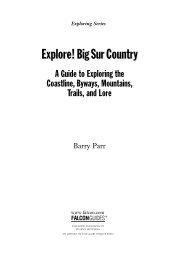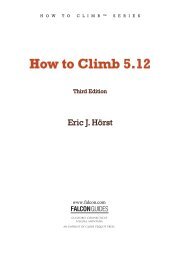A Field Guide to Poison Ivy, Poison Oak, and ... - Falcon Guides
A Field Guide to Poison Ivy, Poison Oak, and ... - Falcon Guides
A Field Guide to Poison Ivy, Poison Oak, and ... - Falcon Guides
You also want an ePaper? Increase the reach of your titles
YUMPU automatically turns print PDFs into web optimized ePapers that Google loves.
A <strong>Field</strong> <strong>Guide</strong> <strong>to</strong><br />
<strong>Poison</strong> <strong>Ivy</strong>, <strong>Poison</strong> <strong>Oak</strong>,<br />
<strong>and</strong> <strong>Poison</strong> Sumac<br />
Prevention <strong>and</strong> Remedies<br />
Third Edition<br />
Susan Carol Hauser<br />
Foreword by William L. Epstein, M.D.<br />
www.falcon.com
Chapter 1<br />
The Toxic Trio<br />
Nature’s hostility <strong>to</strong> human interference is usually manifest<br />
on a large scale, in such phenomena as global warming<br />
<strong>and</strong> ozone-layer deterioration. These retributions<br />
affect all living things. But the revenge wrought by poison<br />
ivy, poison oak, <strong>and</strong> poison sumac is reserved exclusively<br />
for the human inhabitants of planet Earth. Bears, birds,<br />
<strong>and</strong> other wild creatures eat the berries <strong>and</strong> sleep among<br />
the leaves with no ill effects.<br />
The most common ill effect suffered by humans is a<br />
dermatitis caused by contact with the plants’ oils. Rashes<br />
<strong>and</strong> blisters erupt on the skin, sometimes oozing <strong>and</strong> weeping,<br />
<strong>and</strong> always causing a pernicious itch. Less common<br />
<strong>and</strong> more dangerous is contact with the smoke of burning<br />
poison ivy, oak, or sumac plants or their parts. The oil that<br />
causes the allergic reaction is carried in smoke <strong>and</strong> can<br />
l<strong>and</strong> on skin <strong>and</strong> in eyes <strong>and</strong> ears <strong>and</strong> can even be inhaled,<br />
causing serious lung problems.<br />
In North America, poison ivy <strong>and</strong> poison oak grow<br />
happily from Mexico <strong>to</strong> Nova Scotia, except in the desert<br />
areas of the southwestern United States. Their growth<br />
requirements are simple. They prefer an elevation under<br />
4,000 feet. They prefer sunshine but will do without. They<br />
favor drier soils but <strong>to</strong>lerate moisture. They love ground<br />
that has been disturbed <strong>and</strong> multiply freely on road<br />
embankments <strong>and</strong> along forest trails. They spread happily<br />
in city parks, such as Central Park in New York City, <strong>and</strong> in<br />
suburban backyards.<br />
Although poison ivy, oak, <strong>and</strong> sumac are essentially the<br />
same plant, poison ivy resides in the eastern, midwestern,
2 A <strong>Field</strong> <strong>Guide</strong> <strong>to</strong> <strong>Poison</strong> <strong>Ivy</strong>, <strong>Poison</strong> <strong>Oak</strong>, <strong>and</strong> <strong>Poison</strong> Sumac<br />
Toxicodendron distribution in the United States. It is not indigenous <strong>to</strong><br />
Alaska or Hawaii but extends north in<strong>to</strong> Canada <strong>and</strong> south in<strong>to</strong> Mexico.<br />
<strong>and</strong> northwestern United States, north in<strong>to</strong> Canada, <strong>and</strong><br />
south in<strong>to</strong> Mexico. <strong>Poison</strong> oak prefers the East <strong>and</strong> West<br />
Coasts <strong>and</strong> some south-central areas of the United States.<br />
Aside from geography, the primary difference between the<br />
oaks <strong>and</strong> ivies is the shape of the leafl ets.<br />
<strong>Poison</strong> sumac, the largest of the three, contains the<br />
same allergen as poison oak <strong>and</strong> ivy <strong>and</strong> causes the same<br />
reaction. But sumac is particular about its habitat. It resides<br />
in swamps from Maine <strong>to</strong> Florida, west <strong>to</strong> the Mississippi<br />
River, <strong>and</strong> occasionally north <strong>to</strong> eastern Canada. Because<br />
of its reclusive nature, it is not much of a pest.<br />
Actually none of the three would be a threat if it were<br />
possible <strong>to</strong> avoid exposure <strong>to</strong> them. This proves, however,<br />
<strong>to</strong> be nigh un<strong>to</strong> impossible for anyone who likes <strong>to</strong> be out<br />
in nature. <strong>Poison</strong> ivy <strong>and</strong> oak are especially ubiqui<strong>to</strong>us,<br />
<strong>and</strong> sneaky. They grow as small shrubs, as tall shrubs, <strong>and</strong><br />
as long vines that creep along the forest fl oor or up in<strong>to</strong><br />
the tree<strong>to</strong>ps.<br />
The most common advice for avoiding poison ivy <strong>and</strong><br />
oak is the old saw, “Leaves of three, let it be.” Strict appli-
The Toxic Trio 3<br />
cation of this rule may be appropriate for the occasional<br />
woods w<strong>and</strong>erer who is willing <strong>to</strong> remain on a beaten<br />
path. But for the nature lover who wants <strong>to</strong> get up close<br />
<strong>and</strong> friendly with local fauna, it is far <strong>to</strong>o restrictive: Many<br />
benign forest plants have three leaves, or three leafl ets.<br />
As with most easy advice, in the end even the more<br />
specifi c “leafl ets three, let it be” not only encourages<br />
excessive precaution, it does not render absolute protection.<br />
Both poison oak <strong>and</strong> ivy have compound leaves that<br />
are usually arranged in three leafl ets, but they may have<br />
up <strong>to</strong> eleven leafl ets.<br />
The person who wants <strong>to</strong> be spared two weeks of<br />
scratching as payment for a weekend in the country<br />
should not only count leafl ets but also learn <strong>to</strong> recognize<br />
leaf <strong>and</strong> plant shapes. In its usual perverse way, nature<br />
does not make this easy. <strong>Poison</strong> ivy leafl ets are usually oval<br />
<strong>and</strong> lightly <strong>to</strong>othed. <strong>Poison</strong> oak leafl ets are usually slightly<br />
lobed, like oak tree leaves. Where their ranges overlap—in<br />
the Midwest, for example—the oaks <strong>and</strong> ivies hybridize,<br />
<strong>and</strong> newcomers may be classifi ed as both. In addition, offspring<br />
from root stalks reproduce true <strong>to</strong> their source, but<br />
those from seed may go their own way. As of 1986, according<br />
<strong>to</strong> an article in Clinics in Derma<strong>to</strong>logy, the poison ivy species<br />
known as Toxicodendron radicans had nine identifi ed<br />
subspecies (sometimes called varieties or cultivars).<br />
Fortunately whatever the intricacies of their shapes,<br />
the oaks <strong>and</strong> ivies are predictably similar in other important<br />
ways. The leafl ets of both plants are usually about<br />
four inches long. Their stems are woody. Climbing varieties<br />
have visible aerial roots. The leafl ets are usually<br />
shiny—sometimes described as waxy—although they may<br />
also be dull or hairy, especially underneath. They start out<br />
a bright green <strong>and</strong> <strong>to</strong>ward late summer <strong>and</strong> fall turn yellowish<br />
or reddish, then bright red.<br />
When in bloom or gone <strong>to</strong> seed, poison oak <strong>and</strong> ivy<br />
are easier <strong>to</strong> distinguish from other plants. Variations in
Also extends south in<strong>to</strong> Mexico. USDA, NRCS. 2007.<br />
<strong>Poison</strong> ivy, Toxicodendron<br />
radicans Shrub or climbing<br />
vine. Shape of leafl et varies;<br />
occasionally has one<br />
lobe. Usually three leafl ets<br />
<strong>to</strong> a leaf, but may have<br />
more. Berries are smooth<br />
<strong>and</strong> green at fi rst, then<br />
whitish <strong>and</strong> usually hairy.<br />
Stems are sometimes<br />
hairy. Aerial rootlets.<br />
Illustration by Vivienne<br />
Morgan.
Also extends north in<strong>to</strong> Canada. USDA, NRCS. 2007.<br />
Rydberg’s poison ivy,<br />
Toxicodendron rydbergii. Low,<br />
non-vining shrub. Leafl et<br />
shape may vary, but is rarely<br />
lobed. Usually three leafl ets<br />
<strong>to</strong> a leaf, but can have more.<br />
Leafl ets may be hairy on<br />
their undersides. Berries are<br />
smooth <strong>and</strong> green at fi rst,<br />
then smooth <strong>and</strong> whitish.<br />
Illustration by Vivienne<br />
Morgan.
USDA, NRCS. 2007.<br />
leaf<br />
leafl et<br />
Eastern poison oak, Toxicodendron<br />
pubescens. Non-vining<br />
shrub. Leafl et shape highly<br />
variable from lobed <strong>to</strong> unlobed,<br />
but often resembles<br />
white oak. Usually three<br />
leafl ets <strong>to</strong> a leaf, but can have<br />
more. Stems <strong>and</strong> leaves have<br />
fi ne hairs. Berries are smooth<br />
<strong>and</strong> green at fi rst, then hairy<br />
<strong>and</strong> whitish. Illustration by<br />
Vivienne Morgan.
Contents<br />
Foreword by William L. Epstein, M.D ix<br />
Preface <strong>to</strong> the <strong>Field</strong> <strong>Guide</strong> Edition xiii<br />
Acknowledgments xv<br />
Introduction xvii<br />
How the author came <strong>to</strong> care about poison ivy, poison oak,<br />
<strong>and</strong> poison sumac.<br />
Chapter 1: The Toxic Trio 1<br />
Identifying poison ivy, poison oak, <strong>and</strong> poison sumac by<br />
location, description, <strong>and</strong> name; <strong>and</strong> an introduction <strong>to</strong><br />
the mysteries of the offending oil, urushiol.<br />
Chapter 2: War S<strong>to</strong>ries <strong>and</strong> Old Wives’ Tales 19<br />
The his<strong>to</strong>ry <strong>and</strong> lore of poison ivy, poison oak, <strong>and</strong> poison<br />
sumac; how urushiol sneaks around; <strong>and</strong> a compendium<br />
of dastardly home remedies.<br />
Chapter 3: Chicken Little <strong>and</strong> the FDA 31<br />
How the human body, medical science, <strong>and</strong> the Federal<br />
Drug Administration react <strong>to</strong> urushiol.<br />
Chapter 4: The Demon Itch 49<br />
A guide <strong>to</strong> the secrets of avoiding exposure <strong>and</strong> treating<br />
reactions.<br />
Chapter 5: Foreign L<strong>and</strong>s <strong>and</strong> Farmer Birds 67<br />
How poison ivy, poison oak, <strong>and</strong> poison sumac travel; <strong>and</strong><br />
consideration of their management <strong>and</strong> eradication.<br />
Bibliography 81<br />
Index 85<br />
About the Author 94
Copyright © 1996, 2001, 2008 by Susan Carol Hauser<br />
Previously published by The Lyons Press as Outwitting <strong>Poison</strong> <strong>Ivy</strong> in 2001<br />
<strong>and</strong> Nature’s Revenge in 1996.<br />
Foreword copyright © 1996, 2001, 2008 by William L. Epstein, M.D.<br />
ALL RIGHTS RESERVED. No part of this book may be reproduced or transmitted<br />
in any form by any means, electronic or mechanical, including pho<strong>to</strong>copying<br />
<strong>and</strong> recording, or by any information s<strong>to</strong>rage <strong>and</strong> retrieval system,<br />
except as may be expressly permitted in writing from the publisher. Requests<br />
for permission should be addressed <strong>to</strong> The Globe Pequot Press, Attn: Rights<br />
<strong>and</strong> Permissions Department, P.O. Box 480, Guilford CT 06437.<br />
<strong>Falcon</strong> <strong>and</strong> <strong>Falcon</strong><strong>Guide</strong>s are registered trademarks of Morris Book Publishing,<br />
LLC.<br />
Text design by Sheryl P. Kober<br />
Grateful acknowledgment is made <strong>to</strong> the following for permission <strong>to</strong><br />
reprint previously published material:<br />
Arnoldia: Illustrations from “<strong>Poison</strong> <strong>Ivy</strong> <strong>and</strong> Its Kin,” © 1975 by Arnoldia.<br />
Reprinted by permission of Arnoldia.<br />
Clinics in Derma<strong>to</strong>logy: Illustrations from “Toxicodendrons in the United<br />
States,” © 1986 by Clinics in Derma<strong>to</strong>logy. Reprinted by permission of<br />
Elsevier Science, Inc.<br />
Rhodora: Illustrations from “The Systematics <strong>and</strong> Ecology of <strong>Poison</strong> <strong>Ivy</strong><br />
<strong>and</strong> <strong>Poison</strong> <strong>Oak</strong>,” © 1971 by Rhodora. Reprinted by permission of Rhodora.<br />
Library of Congress Cataloging-in-Publication Data<br />
Hauser, Susan, 1942-<br />
[Nature’s revenge]<br />
A fi eld guide <strong>to</strong> poison ivy, poison oak, <strong>and</strong> poison sumac : prevention<br />
<strong>and</strong> remedies / Susan Carol Hauser ; foreword by William L. Epstein. —<br />
3rd ed.<br />
p. cm.<br />
“Previously published by The Lyons Press as Outwitting <strong>Poison</strong> <strong>Ivy</strong> in 2001<br />
<strong>and</strong> Nature’s Revenge in 1996.” —Preface.<br />
Includes bibliographical references <strong>and</strong> index.<br />
ISBN 978-0-7627-4741-2<br />
1. Urushiol—Toxicology. 2. <strong>Poison</strong> ivy. 3. <strong>Poison</strong> oak. 4. <strong>Poison</strong> sumac.<br />
I. Title.<br />
RA1242.U78H38 2008<br />
615.9'52377—dc22<br />
2007049923<br />
Printed in the United States of America<br />
10 9 8 7 6 5 4 3 2 1<br />
The author <strong>and</strong> The Globe Pequot Press assume no liability for accidents<br />
happening <strong>to</strong>, or injuries sustained by, readers who engage in the<br />
activities described in this book.








